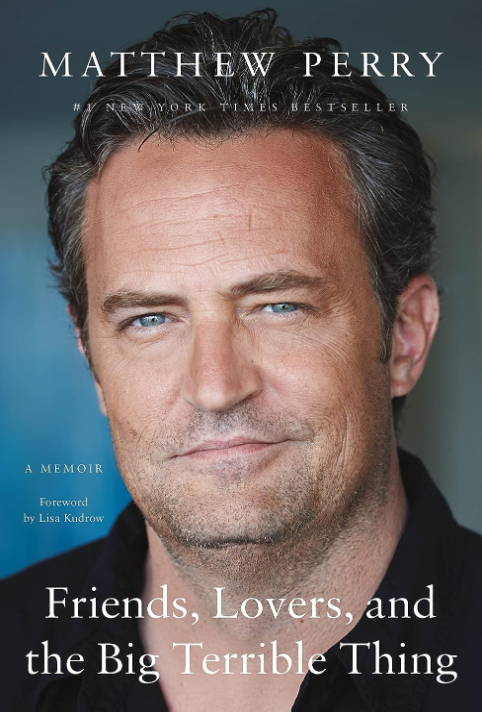When you think of someone with a substance use disorder, what characteristics come to mind? Do you envision someone of a certain race, gender, or socioeconomic class? Are they dirty, lazy, and violent? This is the damaging stereotype society has created of an “addict.” The reality of addiction is that it does not care who you are, what you look like, or how much money or education you have; it will devastate all it touches. Matthew Perry’s story is a clear example.

In his memoir, Friends, Lovers, and the Big Terrible Thing, Matthew Perry describes his life starting from the very beginning – growing up in a “broken” home — to stardom. And his addictions are woven throughout. He reveals the explicit details of his drug and alcohol use. Perry’s story is living proof that addiction is a disease that can affect anyone, and the path to recovery is not a simple or easy process.
Perry’s history with alcohol began before fame and money, as a 14-year-old boy trying alcohol for the first time with some friends and learning the power held within the bottle. While all his friends were sick from the alcohol consumed, Perry felt, for the first time in his life, “complete, at peace.” His alcohol use continued into young adulthood when he realized it had become an obsession and something his peers were not struggling with. He was consuming what most would consider a worrisome amount of alcohol and doing so alone. As Perry realized his disease was controlling his life, he hid it, managing to show up to work every day, even after long nights of drinking. He did not want anyone to think he was broken, and most importantly, he feared they would make him quit drinking. For him, quitting seemed impossible, like asking someone to stop breathing.
The introduction of opioids into his life began in an all too common way – following an injury. It was the ‘90s when physicians readily prescribed opioids. We had not yet fully appreciated the long-term complications that prescribed opioids would cause. Perry took one pill and was “hooked.” He began taking Vicodin (acetaminophen and hydromorphone) daily, eventually needing 55 pills a day for maintenance. As tolerance developed, Perry eventually transitioned to OxyContin (oxycodone), a more potent opioid, but swore he would never use heroin. His opioid use eventually led to life-threatening complications when his colon “exploded” in 2019. Perry, like others with a substance use disorder, understood that drug and alcohol use could lead to death, but the disease does not care. His addiction continued despite the potential dire consequences.
Over the years, Matthew Perry made multiple quit attempts, writing that he attended drug detox and rehabilitation programs 15 times and spent millions of dollars on recovery. According to the National Institute of Health, relapse is common and an expected part of recovery.1 About 40-60% of people with a substance use disorder will relapse.2 Perry’s first experience in rehab was in 1996 after a girlfriend took him to a doctor, and he was referred to a facility. He writes that he learned nothing from that experience and had his first drink 68 days after his discharge. Even Perry, a celebrity who could afford to be treated by the best of the best, did not receive appropriate education or support on how to maintain sobriety in the many rehab programs he participated. Eventually, he learned about Alcoholics Anonymous (AA) and began to understand the principles of addiction and treatment. During Perry’s treatment, he tried both methadone and buprenorphine. In the book, he focused on his experience with buprenorphine and described it as a very helpful drug. Despite its significant benefits, he explained the difficulties and pain that came when he tried to stop buprenorphine — so he remained on it until his passing. Perry’s story proves that sobriety isn’t easy and spending lots of money doesn’t fix addiction. It is not a matter of willpower. It is a disease that requires rewiring the brain.
“I am me. And that should be enough, it always has been enough. I was the one who didn’t get that. And now I do. I’m an actor. I’m a writer. I’m a person. And a good one at that. I want good things for myself, and others, and I can continue to work for these things. There is a reason I’m still here. And figuring out why is the task that has been put in front of me. And it will be revealed. There is no rush, no desperation. Just the fact that I am here, and I care about people, is the answer. Now when I wake up, I wake up curious, wondering what the world has in store for me, and I for it. And that’s enough to go on.”
–Matthew Perry, exerpted from Friends, Lovers, and the Big Terrible Thing
Matthew Perry spent most of his life searching for something to make him whole but came up short. Drugs and alcohol were the only things he found to patch his holes or at least make him forget the emptiness. He was finally able to discover that he, himself, was enough, and only then was he able to find sobriety. At the time of his death, Perry was sober for almost 2 years, taking it day by day to overcome The Big Terrible Thing.
References
The National Institute of Drug Abuse (NIDA). Drugs, Brains, and Behavior: The Science of Addiction. August 3, 2021.
McLellan AT, Lewis DC, O’Brien CP, et al. Drug Dependence, a Chronic Medical IllnessImplications for Treatment, Insurance, and Outcomes Evaluation. JAMA 2000; 284 (13): 1689-95.
